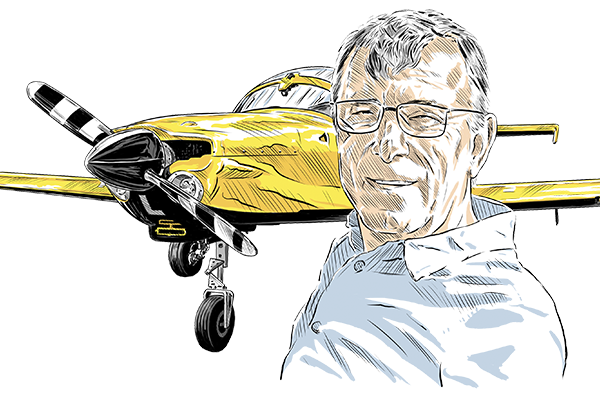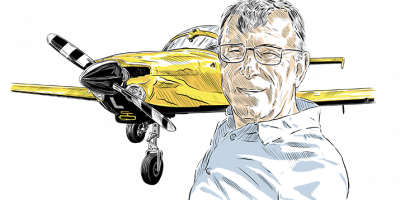At 1300 on the day of the accident, the pilot of a Cessna 182G, reg G-OMAG, took off from Bodmin Aerodrome en route to Dunkeswell Aerodrome to deliver the aircraft to its owner following an annual inspection. He had obtained ‘prior permission’ from the aerodrome operator and was expected by their staff. At 1305, the pilot of a Stearman A75 biplane, reg N68427, took off from Dunkeswell, his home base, for a flight in the local area. After take-off he departed the circuit to the north, maintaining a listening watch with Dunkeswell Radio.
The weather was reported by various witnesses to be ‘workable’ with overcast cloud at 1,200ft above the aerodrome, and patches of lower cloud at 600 to 800ft above surface level in the vicinity of Dunkeswell. Cloud bases were reported to be above 3,000ft amsl to the north. Visibility was approximately 5km and the wind was light from the south-west.
At around 1326 the Cessna was north abeam Exeter and the pilot informed Exeter Radar that he was continuing with Dunkeswell Radio. He established communications with Dunkeswell Radio, requesting the airfield details. A radio operator informed him that Runway 22 was in use, with a QFE of 986 hPa.
At approximately the same time, the Stearman rejoined the Dunkeswell circuit from the east and positioned on a left base for Runway 22. The pilot reported that he made a radio call indicating his intention to join the circuit but could not recall receiving an answer.
At 1329, the Stearman completed a touch-and-go landing and continued into the left-hand visual circuit, achieving a downwind height of 750ft. The Cessna was now approximately one nautical mile to the west and the pilot made a track change to the left, onto a northerly heading, to arc around the aerodrome to position to join the circuit from the deadside onto a right base for Runway 22.
G-OMAG
The Cessna pilot reported that he continued toward final approach at approximately 600ft aal, and when established on final, transmitted ‘golf alpha golf final 22’. He reported that no radio calls were heard after his initial contact with Dunkeswell Radio and that he believed he was joining an empty circuit.
Following a normal powered approach at approximately 70mph, the Cessna landed just beyond the displaced threshold, intending to turn off at the runway intersection. The groundspeed was allowed to decay and the flaps were retracted. With around 100m to go to the intersection, the pilot reported that he heard and felt what seemed like an ‘explosion’ and then became aware of propeller blades rotating in front of his face. He recalled that the cockpit was filled with debris from the shattered windshield, shards of metal and splintered wood.
N68427
At the point the Cessna was approximately one nautical mile from the runway threshold, CCTV footage showed the Stearman flying a curving left base leg, descending from downwind. The pilot was not aware that the Cessna had joined the circuit and had heard no radio transmissions.
The pilot reported that he made a radio transmission as he started the base leg, then again when established on final. He then heard a final call from another aircraft and, assuming it was an aircraft positioning behind him, made an information call: ‘November 27 final close to threshold’. There was no response from the other aircraft, so he continued with the approach. CCTV footage showed that the Cessna had passed ahead of, and below, the Stearman before the Stearman had completed the base turn. Various witnesses reported seeing both aircraft on the final approach in very close proximity, ‘as though in formation’.
The pilot reported that the landing ‘didn’t feel right’ and that the aircraft was not responding to control inputs. He applied power to correct what he felt was a drift to the left, then reduced power to idle. The aircraft continued to swing further to the left, off the runway and onto the grass.
The pilot believed that the left landing gear had failed. Once the aircraft stopped, he looked down and saw that his aircraft was straddled on top of another aircraft, the Cessna.
Nick’s analysis
The two pilots involved in this accident thankfully had a lucky escape, as we can imagine the results of the collision had occurred a few seconds earlier with both aircraft still airborne. Since this accident, the CAA has tightened up the guidance for pilots in receipt of Air to Ground Service at airfields.
The accident highlights the problems and potential dangers in operating into small airfields with limited – or perhaps no – information available on circuit traffic. Since every flight ends with some sort of joining procedure, it is worth considering some factors before we get to that stage of the flight – the part we might find is the busiest!
If flying to a new airfield, spend some time reviewing that airfield’s published information as part of your planning process. This information may be in the UK Aeronautical Information Package (AIP), or on the airfield’s website, or both! Note if the airfield operates with full ATC, a Flight Information Service Officer (FISO), or Air to Ground Operator.
If you need to get prior permission (PPR) by phone, that is the time to clarify their procedures if you are not clear on them. Some airfields may not have a deadside, for example, so an Overhead Join may not be applicable. With airfield information collated, have a think about how your arrival to the airfield will work, based on your arrival direction. I find that a lot of pilots spend lots of time planning navigation routes to perfection but forget completely to think of any sort of plan to join the destination airfield circuit.
Once airborne and approaching your destination airfield, I recommend that you get onto the appropriate airfield frequency early – perhaps 10 minutes before arrival if the situation allows. Having selected the airfield frequency, say nothing for now – just listen.
A number of options will open up for you:
If the frequency is busy with traffic and responses from ATC, continue listening: you should be able to start working out what’s going on, which runway is in use and QFE, and plan your circuit join. With those items out of the way, you can then make your call to the airfield and continue as required.
If the frequency is quiet, there may be a number of issues. First check that you have the correct frequency! It sounds obvious, but I do see pilots setting incorrect frequencies frequently, more so now with unfamiliar 8.33 KHz figures.
In a similar vein, check that the radio volume has not been inadvertently turned down! Assuming all is well with the radio, make a call to the airfield and await the response. With a response received, continue with the joining procedure as directed. Hopefully that procedure will be as you had considered before flying but be ready for a different join – in this case, make sure you are clear in your mind how that new join will work out. If there is any doubt, stay away from the circuit as you work out how to join. Don’t just blunder into the airfield pattern!
If there is no response from the airfield or other traffic, proceed with more caution. Continue with the airfield circuit join as you planned beforehand, assuming there is no obvious change to, for example, runway in use. If weather allows it may be prudent to stay above the ATZ (if there is one) so that you can check the windsock or even the good old-fashioned signal square! Make ‘blind’ calls to alert other pilots of your intentions: ‘XXX Traffic, G-ABCD, inbound from the east, joining overhead for Runway 27 left-hand’. Make other calls if you think it will enhance other pilots’ awareness, but you should certainly make calls at the standard positions (downwind, final etc). Be aware that there may be non-radio traffic around in the midst of all this, so make sure that you are looking out through all of this process – and that includes looking up and down, as well as ahead.
If there is traffic on frequency in the circuit, make sure that you fit in with that traffic. If other traffic is also joining the circuit (as in the accident scenario), be cautious and hold off from the circuit if you are in any doubt about which of you might be ahead in the circuit joining process.
If you don’t feel safe as you join the airfield pattern, don’t be afraid to leave the circuit again by some sensible route and think again before heading back.
Don’t get distracted by passengers who may be excited at the prospect of seeing the airfield and who may not understand the workload you may be under!
Key takeaways
* Research the airfield procedures pre-flight and make a provisional plan for the arrival join.
* Listen out early on the airfield frequency.
* With no response, proceed with caution, making blind calls in standard positions or elsewhere to assist with awareness.
* Hold off away from the circuit if not absolutely clear about other aircraft positions.
* Keep looking out for all traffic, including unannounced non-radio aircraft.
There’s an in-depth discussion about this accident on the FLYER forum. Click here to read and comment.





